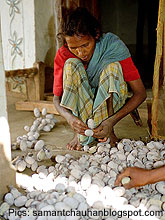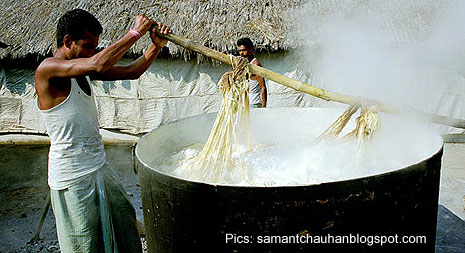 Sustainable fashion that propagates awareness towards the disturbed ecosystem strives to awaken the most laid back, non reactive fashion society. Sustainability is a relative term which can also be interpreted as to live and let live. Fashionfad.in sits together with the proactive Ahimsa Silk Designer Samant Chauhan and an anthropologist Phyllida Jay, working for a research project on sustainable fashion and more precisely organic cotton in India, to unravel the true essence of sustainability in fashion.
Sustainable fashion that propagates awareness towards the disturbed ecosystem strives to awaken the most laid back, non reactive fashion society. Sustainability is a relative term which can also be interpreted as to live and let live. Fashionfad.in sits together with the proactive Ahimsa Silk Designer Samant Chauhan and an anthropologist Phyllida Jay, working for a research project on sustainable fashion and more precisely organic cotton in India, to unravel the true essence of sustainability in fashion. The entire awakening for sustainability was instigated by Katherine Hamnett, a British designer when she discovered that the fashion industry was responsible for a living environmental nightmare and felt the moral imperative to do something and the only solution to the catastrophe was to go green in 2000.
The Organic cotton by definition is cotton grown without the use of pesticides or chemical fertilizers. The standards at different levels exist, however, for cotton to be classed as organic it must be grown in soil that has been chemical-free for at least the last three years.
Conventional cotton represents 10% of world agriculture and uses 25% of the world’s pesticides.
The clothing, shoe and textile industry is one of the largest industries in the world and is responsible for enormous pollution and environmental destruction. The industry uses more water th an any other, apart from agriculture. It discharges massive quantities of toxic chemicals into the environment including huge amounts of dioxins, from bleach, lycra, PVC and heavy metals in dyes and leather tanning. It uses huge amounts of energy in the form of oil and electricity – in manufacturing and the production of synthetics, shipping, and air travel. Thus it is responsible for enormous CO2 and greenhouse gas emissions and is a significant contributor to climate change. And still we sit unmoved thinking it hardly affects us. But we have forgotten the chain of ecosystem where even if the lowest link is disturbed it disturbs the entire cycle and soon the fashion community will be the direct recipients of its adverse affect if we continue to be ignorant any longer.
an any other, apart from agriculture. It discharges massive quantities of toxic chemicals into the environment including huge amounts of dioxins, from bleach, lycra, PVC and heavy metals in dyes and leather tanning. It uses huge amounts of energy in the form of oil and electricity – in manufacturing and the production of synthetics, shipping, and air travel. Thus it is responsible for enormous CO2 and greenhouse gas emissions and is a significant contributor to climate change. And still we sit unmoved thinking it hardly affects us. But we have forgotten the chain of ecosystem where even if the lowest link is disturbed it disturbs the entire cycle and soon the fashion community will be the direct recipients of its adverse affect if we continue to be ignorant any longer.
 an any other, apart from agriculture. It discharges massive quantities of toxic chemicals into the environment including huge amounts of dioxins, from bleach, lycra, PVC and heavy metals in dyes and leather tanning. It uses huge amounts of energy in the form of oil and electricity – in manufacturing and the production of synthetics, shipping, and air travel. Thus it is responsible for enormous CO2 and greenhouse gas emissions and is a significant contributor to climate change. And still we sit unmoved thinking it hardly affects us. But we have forgotten the chain of ecosystem where even if the lowest link is disturbed it disturbs the entire cycle and soon the fashion community will be the direct recipients of its adverse affect if we continue to be ignorant any longer.
an any other, apart from agriculture. It discharges massive quantities of toxic chemicals into the environment including huge amounts of dioxins, from bleach, lycra, PVC and heavy metals in dyes and leather tanning. It uses huge amounts of energy in the form of oil and electricity – in manufacturing and the production of synthetics, shipping, and air travel. Thus it is responsible for enormous CO2 and greenhouse gas emissions and is a significant contributor to climate change. And still we sit unmoved thinking it hardly affects us. But we have forgotten the chain of ecosystem where even if the lowest link is disturbed it disturbs the entire cycle and soon the fashion community will be the direct recipients of its adverse affect if we continue to be ignorant any longer. So the entire sustainable fashion conscious society is constantly working-out a methodology that is least harmful and provides the least disturbance to the supply chain network. Sustainably is a relative term and in its mission to accomplish balance it finds that the demand for organic cotton is the route to success. Phyllida on account of her research and her three months stay in India in cities like, Jaipur, Pune, Hyderabad, Mumbai and now Delhi has discovered pockets of awareness which are dispersed. Henceforth, where there is awareness for sustainable fashion, the products are not available and vice versa.
The other side of the quest for sustainable fashion was put forward by Samant Chauhan as he takes care of the livelihoods of each and every stake holder involved in the production of his garments. He works directly with the silk weavers of Bhagalpur and ensures their sustainability in terms of food and proper share of money. The education is also taken care of which diminish the chances of them being cheated by the middle men. And another important aspect of sustainable fashion is to create recycle value of the product thus not increasing the wastage at an alarming rate. There are different routes to be followed to achieve the goal of minimum disturbance and a conscious effort towards ethical upsurge.

The growing fashion fraternity also poses a question very aptly put forward by Samant Chauhan, “When we are working with international companies many a time we are questioned about the facilities for the work force at our studio, but little do they realize the amount of capital involved to go by their standards. And if we are not allowed business on this ground the entire small scale designer industry in India would suffer setback. So how do we maintain the balance?” he says, as he leaves for Ireland in June this year to deliver a lecture on Sustainable fashion at the GMIT, college of arts.
In India the organic cotton farms are held by a few export houses like Pratibha in Indore and Arvind Mills certified by the Organic Exchange body that is a seal of guarantee for organic cotton. The Aditya Birla Group has come up with their latest discovery of Birla Cellulose which is a 100 per cent natural and biodegradable fibre.








